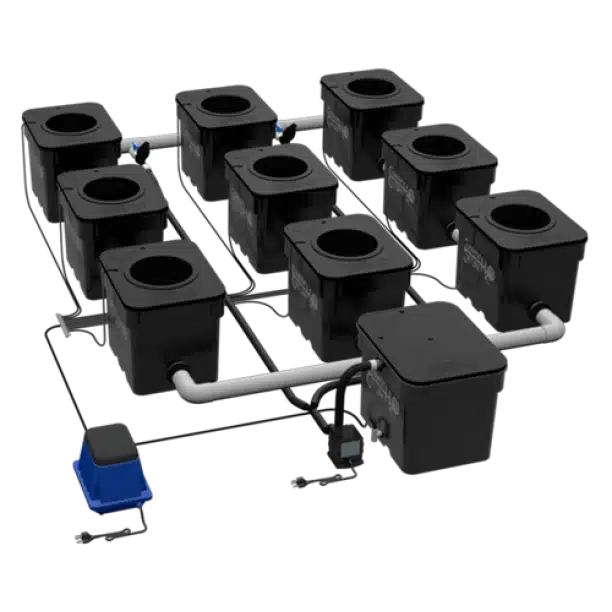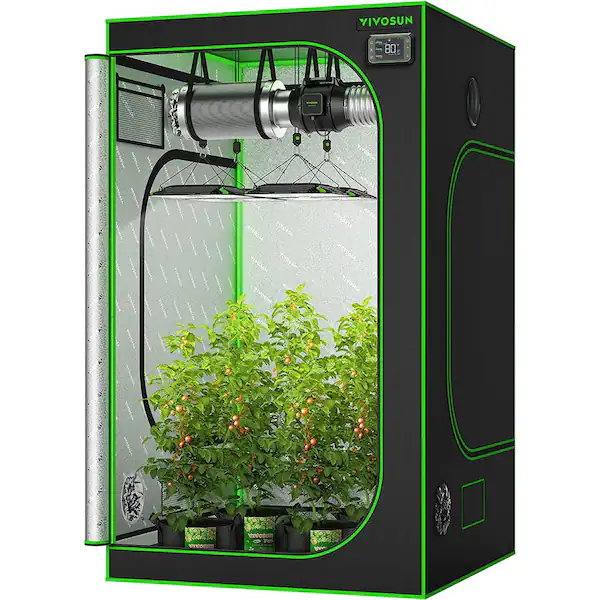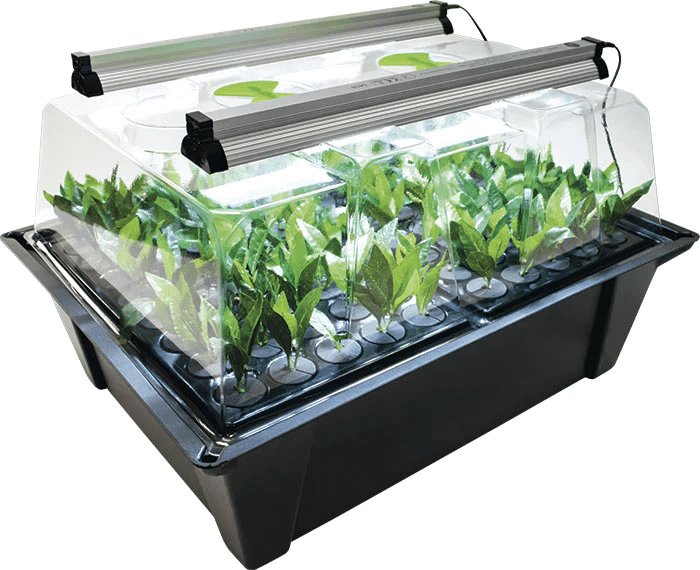Sino Hydroponics
Hydroponics supplies directly from the factory
We are a British owned supplier of Hydroponics products based on the ground in China
- Sourcing
- Samples
- Quality Control
- Payment Protection
- Shipping
Sino Hydroponics is your partner in China for sourcing high-quality hydroponic products at competitive prices. We have direct access to reputable factories and can handle all aspects of branding, production, inspection and shipping for you. We ensure that your orders are delivered on time and meet your expectations. Contact us today and let us help you grow your business with our hydroponic solutions.
Categories

Your Grow Room environment should be one of your first considerations for a successful hydroponics setup.
If you provide your plants with plenty of fresh air, you effectively guarantee a generous supply of carbon dioxide, which plants need for their healthy growth and development.
Proper ventilation in your hydroponic growing area or tent is essential for healthy plant growth. For your plants to develop as they should, it is necessary to clean the air and remove any nasty particles from the environment as much as possible.
Air constantly circulating within any given confined space will also be a good defence against the various biological hazards that can develop over time.
There are well-known diseases that affect plants. These can be kept at bay and under check better if you have a gentle breeze that does not permit local buildup of the kind of micro-organism and bacteria that cause these diseases in the first place or allow them to flourish.

Grow lights in hydroponics are an essential part of any growing system. There are several different types of grow lighting systems and grow lamps available on the market, so be careful when choosing the grow light to use with your hydroponic method and size of installation.
Grow lights in hydroponics come in many shapes, functions and sizes. Many of these may be used successfully in your hydroponics system. The three main categories are fluorescent, high-intensity discharge (HID) and light-emitting diode (LED).
Fluorescent grow lights. This light is the most popular among hydroponic growers because of its relatively low cost and efficiency.
There are two subsets of the fluorescent grow light types: compact fluorescent light (CFL) and tube-style light.
Compact Fluorescent Lights (CFL). CFLs are relatively inexpensive bulbs which can be very versatile in their shape. CFLs are a good choice for minor hydroponic installation because they don’t heat up to a great extent, so you can safely place them next to your plants.
Tube-Style Fluorescent. Tube-style fluorescent lights are available in several different specific types. Tube-style fluorescent lights are wider than their CFL counterparts, generally arranged in parallel rather than in series, and mounted on a sturdy fixed board.
High-Intensity Discharge Grow Lights (HID). HID lights are generally more efficient than fluorescent lights but release more heat; they need continual ventilation. Of these, there are three sub-varieties:
High-Pressure Sodium Lights (HPS). HPS lights give off reds and yellows on the whole colour spectrum. Because of this, HPS grow lights are used more often during the fruiting and flowering stages of plants.
Metal Halide Lights (MH). These emit light within the blue range of the spectrum. Because of this, MH lights are well-suited for the vegetative stages in the life cycle of plants.
Ceramic Metal Halide Lights (CMH). These are similar to MH grow lights on first seeing them. But CMH lights have a broader colour spectrum range than both MH and HPS lights, and they last longer.
Light Emitting Diodes (LED). LEDs are very efficient compared to all the other types of grow light; LEDs emit a large amount of light while only needing very little electricity. They are very lightweight and do not emit much heat. These lights consist of lots of small diodes which produce light. These grow lights may be sourced and arranged to make specific colours on the spectrum.

Grow systems and pots in hydroponics comprise a wide variety of different arrangements of growing apparatus and the many (or few) pots attached to them.
Hydroponic growing systems can start small and build up to almost any size wanted, based on the number of pots often fed from a central system controller, sometimes referred to as its “brain”.
There is a marked crossover between the possibilities of entirely do-it-yourself growing systems and ready-made systems bought from a manufacturer. It’s normal for a great deal of the equipment, especially the pots themselves, to be purchased in stages and the whole system assembled by the grower in a piecemeal way.
Grow Systems and Pots in Hydroponics can embrace several of the six main types of hydroponic growing systems:
- Aeroponic Systems
- Dripper Systems
- DWC Systems (Deep Water Culture)
- Flood and Drain Systems (also known as Ebb and Flow)
- NFT Systems (Nutrient Film Technique)
- Wick Systems (Bottom-Fed)

Grow Tents and Sheeting in Hydroponics are what growers use to house the plants as they grow and develop effectively. Although the terms can be interchangeable, the tent is a more tightly controlled alternative to a growing room, especially if the tent is huge.
Grow tents are one of the crucial pieces of equipment for a truly successful hydroponic grow system because they are the housing and the basis for creating the ideal hydroponic growing environment.
With the grow tent being such an essential part of any growing system, investing in a quality one makes sense. There are some cheap tents which have poor quality zips and stitching. Their frames and corner pieces are often not as sturdy as they need to be, and the bars of these cheaper tents sometimes cannot support loads before bowing.
Grow tent selection is one of the most critical aspects of setting up your growing system, as a poor tent may lead to you having to replace it after a couple of harvests, or you may risk failing. You want a very easy tent to assemble and work in, with strong click-lock poles and sturdy corner pieces. This is important because all the extra weight load of the extraction system and the grow light(s) will require a strong support frame to carry them.
Sheeting in hydroponic set-ups is used either as an alternative to grow tents in rare circumstances, as an addition to the grow tent itself or to patch up where holes or gaps have developed. This sheeting is highly reflective on the inside so that it will bounce the light back into the growing space where it is most valuable, while on the other side, the material will be matt or have some other light-absorbent qualities.

Grow Tents and Sheeting in Hydroponics are what growers use to house the plants as they grow and develop effectively. Although the terms can be interchangeable, the tent is a more tightly controlled alternative to a growing room, especially if the tent is huge.
Grow tents are one of the crucial pieces of equipment for a truly successful hydroponic grow system because they are the housing and the basis for creating the ideal hydroponic growing environment.
With the grow tent being such an essential part of any growing system, investing in a quality one makes sense. There are some cheap tents which have poor quality zips and stitching. Their frames and corner pieces are often not as sturdy as they need to be, and the bars of these cheaper tents sometimes cannot support loads before bowing.
Grow tent selection is one of the most critical aspects of setting up your growing system, as a poor tent may lead to you having to replace it after a couple of harvests, or you may risk failing. You want a very easy tent to assemble and work in, with strong click-lock poles and sturdy corner pieces. This is important because all the extra weight load of the extraction system and the grow light(s) will require a strong support frame to carry them.
Sheeting in hydroponic set-ups is used either as an alternative to grow tents in rare circumstances, as an addition to the grow tent itself or to patch up where holes or gaps have developed. This sheeting is highly reflective on the inside so that it will bounce the light back into the growing space where it is most valuable, while on the other side, the material will be matt or have some other light-absorbent qualities.
- Propagation Lighting
- Propagation Media
- Propagation Nutrients Boosters
- Propagators

Propagation in hydroponics is just another term for the creation of new plants. Many growers propagate using hydroponic techniques to benefit from plants’ early rooting and faster growth rates. These are possible because the hydroponic growing media in use provide the plants’ root zones with easy access to water, vital nutrients and oxygen.
As with any propagation, you first need to decide whether you want to grow your plants from seeds or cuttings. In general, growers who choose to propagate from seeds do this because it gives them peace of mind that their crop will be free of diseases and pests. However, the main drawback with this method is that the attributes of the plants you produce may be inconsistent.
But with cuttings, you will consistently produce plants genetically identical to their healthy parents. It is for this reason cuttings are sometimes referred to as clones.
Other benefits of growing from cuttings include:
- Earlier flowering by comparison
- Generally improved plant stock
- Plant species are more adaptable to variations in climate
Growing your plants from cuttings has several benefits. But for most growers, the first foray will probably start by growing from seeds. It’s better to germinate several seeds simultaneously because you’ll then be in a position to choose a healthy mother plant from which you know you’ll be taking healthy cuttings in future.
Hydroponic growers will have their favourite methods of propagating their plants, but these days many growers will use Rockwool cubes to grow their tiny cuttings. Take care when selecting these cuttings from the mother plant, as these infant plants will be very delicate. Some liquid preparations are available to alleviate the shock of the propagation process.
Rockwool cubes are a popular growing medium for propagation, and for a good reason. The chief advantage of Rockwool is that it can hold more air and water than just about any other growing medium. It’s also sterile and inert and does not cling to the nutrient. The plant roots are visible using this medium, and it’s pretty easy to judge whether these cubes are moist or dry at any given time.
Rockwool cubes are easy to transplant into larger Rockwool cubes, or any other hydroponic medium for that matter, with very little fuss. The cuttings will take about 7 to 14 days to root.
More about the procurement process
Sourcing

- If the Hydroponic product exists, we will have a connection to a vetted factory that makes it at the best price, quality and speed.
- If the product does not exist, we find who can make it for the best price, quality and speed.
- We personally inspect new product samples the day after they are finished, before sending them to you. If the product is not suitable, we will have the factory make adjustments within 24 hrs or find a factory to suit your needs.
- Our bilingual staff allow for clear and quick communication
Quality Control
- We test samples by using them at their extremes.
- When appropriate your China sourcing agent takes the samples apart.
- We arrange for sample 1 to be the standard that all future product quality is legally held to.
- We carry out ongoing quality control through sample testing from 1% – 5% of any order you choose.
- We are able to do factory visits to oversee the manufacturing process.
- We are able to have the samples tested in an independent lab.

Shipping

- We can get it to your chosen freight forwarder in China (FOB), to a port of your choosing in your destination country (DAT) or right to your door (DDP).
- We have the connections and the knowledge to shop around on your behalf. We can provide a quote and you can compare this against your own freight forwarders.
- You can let us take care of all the paperwork and you can focus on the rest of your business.
Pricing
- We offer free services such as a product viability consultation and arranging your shipping.
- We have connections to labs and freight forwarders to bring you the best possible prices.
- We offer discounted prices on services such as product photography.

Blog Posts

Understanding RCM Certification: A Key Requirement for Electrical Equipment in Australia
Introduction to RCM Certification As a manufacturer or consumer of electrical equipment in Australia, understanding the Regulatory Compliance Mark (RCM) certification is crucial. RCM certification
Navigating the Complexities of Quality Control in Chinese Manufacturing
As a business owner or supply chain manager, you understand the importance of quality control in manufacturing. However, when it comes to Chinese manufacturing, quality
How is a 190,000PSI Olympic barbell made?
Your very own man on the ground China sourcing agent visits a factory in China and teaches you how they make high quality Olympic barbells
Avoid getting arrested by not electrocuting your customers. We teach you how to get your products CE/UKCA/UL certified
CE/UKCA/UL. Product conformity, what’s the bid deal?! Table of Contents If your product does not conform to safety standards, you are personally legally liable, not
Eliminate Risk and Don’t get Scammed. Payment Protection in China Using Chinese Sourcing Agents insider secrets
A – Alibaba M – Manufacturing agreement V – Vet manufacturers I – Inspect products Avoid spending money and receiving poor quality, the wrong products
